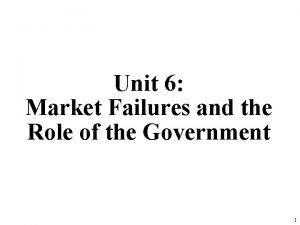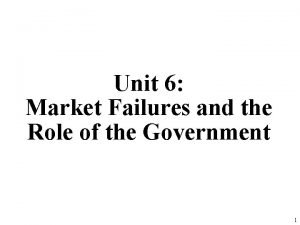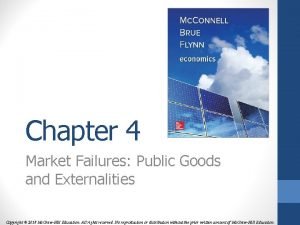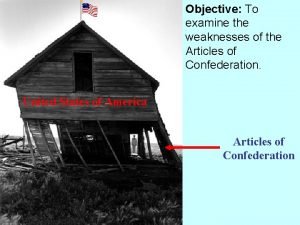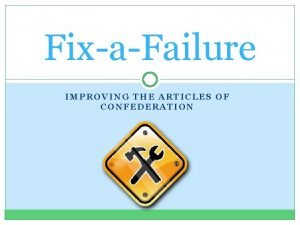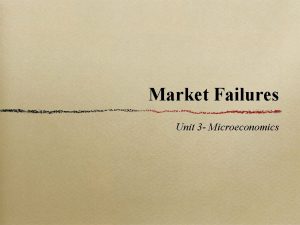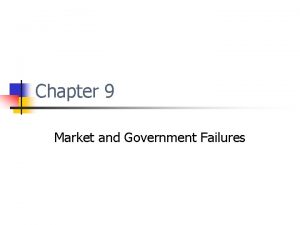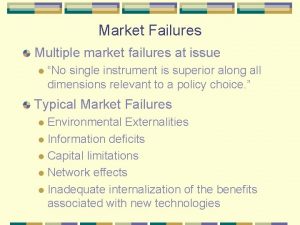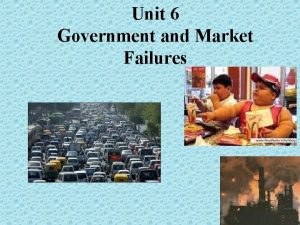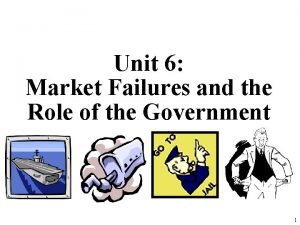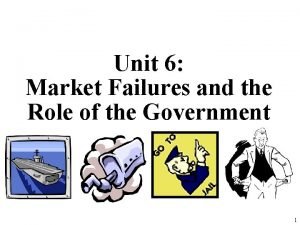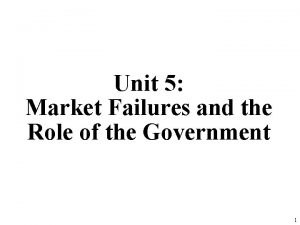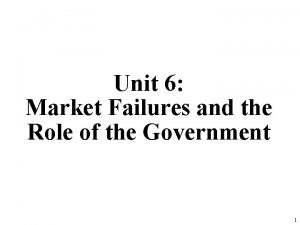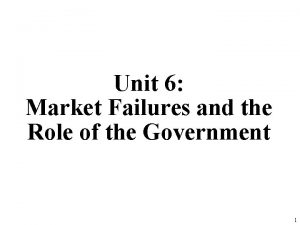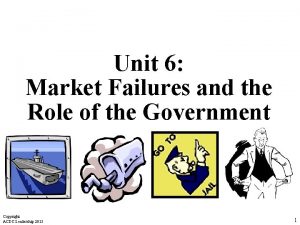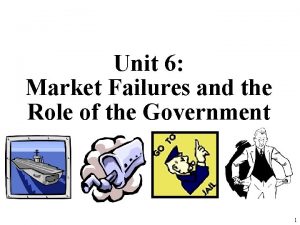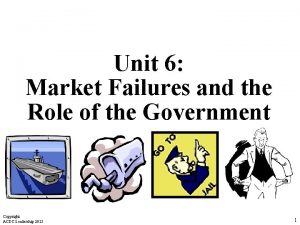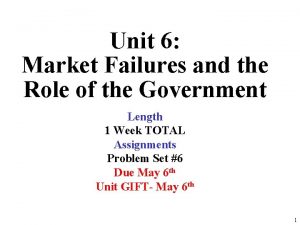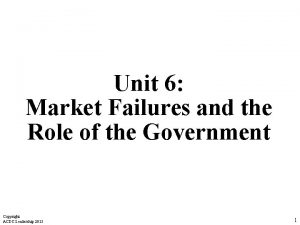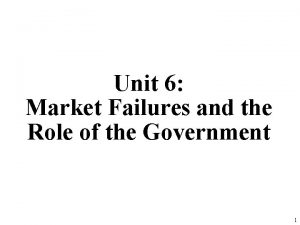Unit 6 Market Failures and the Role of























- Slides: 23

Unit 6: Market Failures and the Role of the Government Length 1. 5 Weeks TOTAL Assignments Problem Set #6 Video Log #6 1

Your Assignment Should You Choose to Accept It…. • Well, even if you don’t choose to accept it, do it anyway. • You will be called upon to give a summary of this lecture at the end of class. • Take notes. Ask questions. In short, strive for understanding of the CORE of the lesson. 2

When should the government get involved in the economy? Worker Safety Laws Barber Shop Licenses Bank Bailouts Every society needs to decide how much government involvement is desirable 3

4

What is the Free Market? (Capitalism) 5

5 Characteristics of Free Markets 1. Little government involvement in the economy. (Laissez Faire = Let it be) 2. Individuals OWN resources and determine what to produce, how to produce, and who gets it. 3. The opportunity to make PROFIT gives people INCENTIVE to produce quality items efficiently. 4. Wide variety of goods available to consumers. 5. Competition and Self-Interest work together to regulate the economy. The government’s job is to enforce contracts, secure property rights, and defend the country. 6

Example of the INVISIBLE HAND of the free market: If society wants computers and people are willing to pay high prices then… • Businesses have the INCENTIVE to start making computers to earn PROFIT. • This leads to more COMPETITION…. • Which means lower prices, better quality, and more product variety. • To maintain profits, firms find most efficient way to produce goods and services. The government doesn’t need to get involved since the needs of society are automatically met. 7

Does the Free Market ever FAIL to meet society’s needs? 8

What is a Market Failure? • A situation in which the free-market system fails to satisfy society’s wants. (When the invisible hand doesn’t work. ) • Private markets do not efficiently bring about the allocation of resources. What’s the result… The government must step in to satisfy society’s wants. Circular Flow Model Review 9

How does the free market FAIL? 10

The Four Market Failures We will focus on four different market failures: 1. Public Goods 2. Externalities (third person side effects) 3. Monopolies 4. Unfair distribution of income In each of the above situations, the government steps in to allocate resources efficiently. 11

Market Failure #1: PUBLIC GOODS

Public Goods Hypothesize: If there was no government, how would • Schools, • Parks, • Freeways • Fire departments • Police service be different? Would there be enough to meet our needs? 13

Public Goods Why must the government provide public goods and services? • It is impractical for the free-market to provide these goods because there is little opportunity to earn profit. • This is due to the Free-Rider Problem Free Riders are individuals that benefit without paying. 14

What’s wrong with this picture? 15

The Free Rider Problem Examples: 1. People who download music illegally 2. People who watch a street performer and don’t pay 3. Teenagers that live at home and don’t have a job 16

Does anyone free ride off you? • Canadian Military Spending: $21. 8 Billion • US Military Spending: $660 Billion Why doesn’t Canada spend more on their military? 17

What’s wrong with Free Riders? • Free-Riders keep firms from making profits. • If left to the free market, essential services would be under produced. Speculate - To solve the problem, the government can: 1. Find new ways to punish free-riders. 2. Use tax dollars to provide the service to everyone. 18

• I teach three AP classes. • I am willing to give a 100% on the final exam to whichever class gives me $1000 and I WILL GUARANTEE a passing grade on the AP Exam. • Everyone in the class will get 100% and passes the exam, even if they don’t pay. • Who is willing to pay? • What about those that refuse to pay? Solution? Speculate… EVERYONE pays a mandatory tax and all receive the same benefits. 19

Definition of Public Goods 20

Definition of Public Goods To be considered a true public good, it must meet two criteria: 1. Nonexclusion • Everyone can use the good. • Cannot exclude people from enjoying the benefits (even if they don’t pay). • Ex: National Defense 2. Shared Consumption (Nonrivalry) • One person’s consumption of a good does not reduce the usefulness to others. • Ex: Whispering Pines Park 21

Identify which of the following are TRUE public goods (have non-exclusion and non-rival consumption): 1. Hamburgers 2. Satellite TV 3. Free Public Education 4. Homes 5. Street lights 6. Highways 22

1. Get into your groups. 2. Using your notes, summarize this lecture on ONE to THREE 8 ½ x 14 sheets of paper. 23
 Unit 6 four market failures
Unit 6 four market failures Unit 6: market failures and the role of the government
Unit 6: market failures and the role of the government Chapter 7 section 1 guided reading
Chapter 7 section 1 guided reading Define market failure
Define market failure Demand-side market failures occur when
Demand-side market failures occur when Perfect competition examples
Perfect competition examples Market failures
Market failures Define market segmentation targeting and positioning
Define market segmentation targeting and positioning Market leader follower challenger nicher
Market leader follower challenger nicher Joseph stalin main accomplishments
Joseph stalin main accomplishments Worker role azure
Worker role azure Failures of the articles of confederation
Failures of the articles of confederation Engineering ethics failures
Engineering ethics failures Pitot static failures
Pitot static failures Why did the articles of confederation fail
Why did the articles of confederation fail Legislative branch
Legislative branch Rpc semantics in the presence of failures
Rpc semantics in the presence of failures Attitude indicator errors
Attitude indicator errors Cloud security failures
Cloud security failures Kublai khan failures
Kublai khan failures Advertising failures
Advertising failures Fixing service failures
Fixing service failures Failures of classical physics
Failures of classical physics 10 steps to equity in education
10 steps to equity in education
